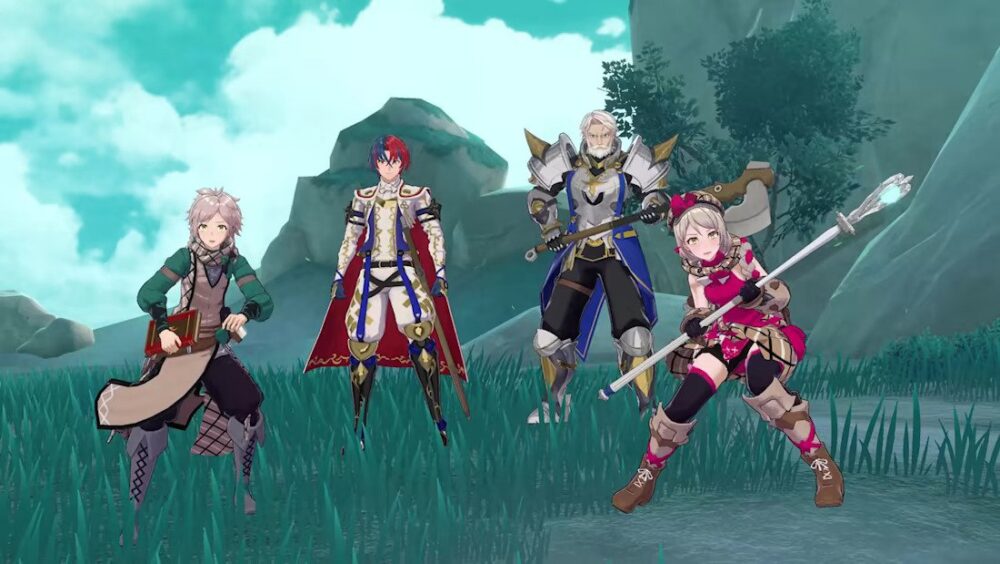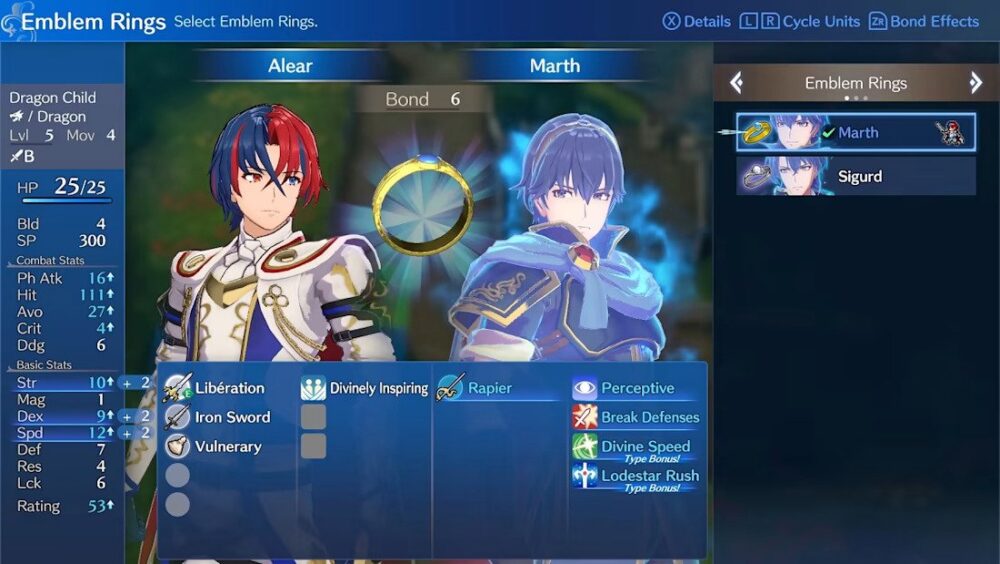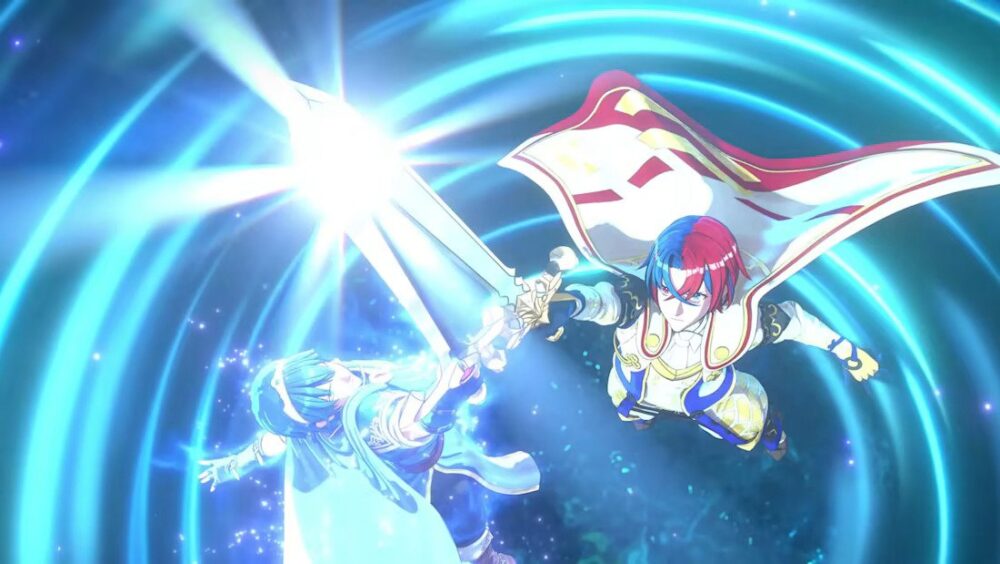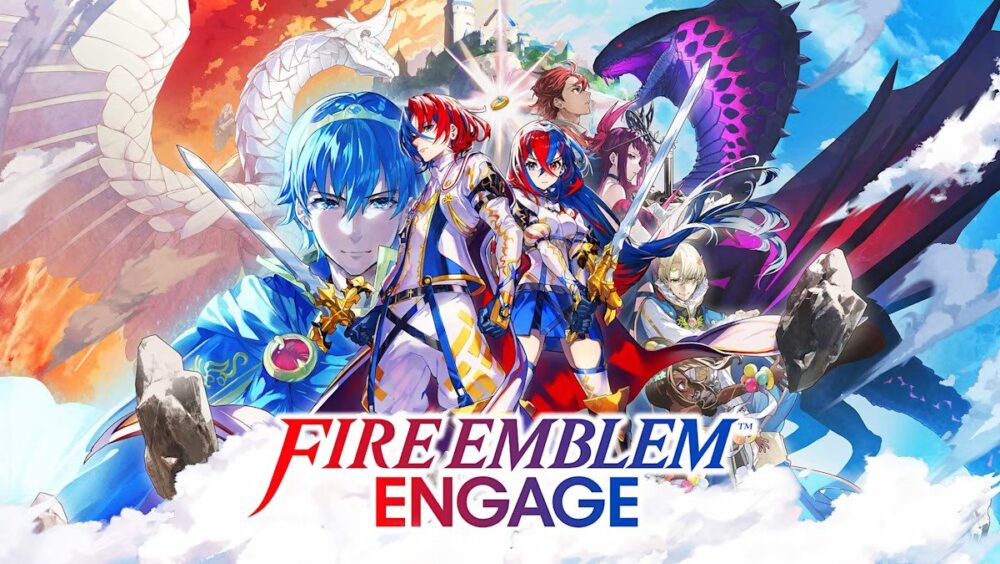Fire Emblem Three Houses was an unmitigated success. Released in 2019, it saw success in the west unlike that of any other game in the series and generated a whole new fanbase for Nintendo’s flagship Tactical RPG franchise. Until then, Fire Emblem had very much catered solely to a committed core fanbase, as most games had either only ever been released in Japan or come across to the west far too late to be relevant. With 3H, Intelligent Systems brought the classic turn-based strategy gameplay up to date and added a myriad of life-sim systems which kept the gameplay refreshing and left the player feeling intimately connected to its overwhelmingly large cast. It also felt endlessly replayable, with four distinct story paths to follow each with its own unique battles and units.
3H was my first venture into Fire Emblem, and I thoroughly enjoyed my time in Fodlan. If anything, my main gripe was with the imbalance between gameplay sections. Half of your time would be spent running around the academy chatting to your comrades yet battles felt too few and far between. Still, it sold incredibly well and quickly became the best-selling entry to date.
The big problem faced by games which break a series’ mould though is the inevitable follow-up. After all, massive success inevitably demands the next product reach even greater heights in the eyes of investors and fans alike. These expectations become even greater with games around big series anniversaries – like the 30th anniversary of Fire Emblem in 2020, which Fire Emblem Engage was originally designed to celebrate. Do developers choose to continue down the new path – potentially alienating their biggest fans – or go back to their roots and try to find a halfway house? With this sequel – Fire Emblem Engage, IS had some big decisions to make; but did their choices and efforts pay off?
Fire Emblem Engage sits in a strange place in terms of story. The world of Elyos – unrelated to the worlds of other titles – is a continent split into five realms and “ruled over” by the Divine Dragon Lumera, worshipped by the inhabitants as a deity. Lythos lies at the centre of the circular continent surrounded by sea, with Firene, Brodia, Elusia and Solm each encompassing one-quarter of the surrounding landmass. For the last thousand years, the world has existed in relative peace – aside from occasional conflicts in border areas – thanks to the combined efforts of the Divine Dragon and her Emblem Rings in defeating and sealing away the Fell Dragon – Sombron. After his fall, Lumera scatters the rings to prevent Sombron from returning – entrusting some to the four kingdoms and one to her child.

The peace is broken when the corrupted – soldiers of the Fell Dragon – appear once more, signalling his return. Simultaneously, the child of the Divine Dragon awakens from their own thousand-year slumber and it’s here that our tale begins.
You play as said Divine Child – by default named Alear, but nicknamed Colgate by the community at large due to their blue/red duo chromatic hair. Choosing your gender, you awaken to meet your protectors – discover you can’t remember anything whatsoever – and travel to Lythos to meet with your mother. Unfortunately, the majority of the rings are quickly stolen in an attack on Lythos, forcing Alear to travel around Elyos searching for the twelve rings so that he can defeat Sombron once and for all.
Unlike previous games, Fire Emblem Engage’s story sets an immediate pace, raising the stakes and introducing the central villain within minutes. I loved how swiftly I was thrown into the action and given control, though arguably the plot as a whole isn’t exactly original. Good Dragon vs Evil Dragon, collecting twelve MacGuffins to defeat the big bad, amnesiac protagonist – the tropes come at you one after another, but what it lacks in originality it makes up for in polish. Three Houses meandered through a magnificent but slow, grounded, politically-charged story and only really picked up around a third in.
Fire Emblem Engage may not have the same level of realism, depth and overall complexity, but it still manages to deliver an interesting plot full of twists, turns and surprises.
The same can be said about the characters of this world. Fire Emblem Engage has a vast cast – bigger even than 3H – but each has less depth and memorability to them. It’s hard to truly pinpoint why, but most just don’t feel anywhere near as compelling as characters from previous titles. When I hear “Leonie” or “Claude”, I instantly think back to the many conversations I had with them during my 3H Golden Deer playthrough. In Fire Emblem Engage, there are a few notable units: Yunaka – a mysterious half-truth-telling thief; Fogado – the charming “spare” of Solm; and Framme/Clanne – the twins who were destined to defend Alear after Vander’s departure; but few are given the spotlight for long enough to truly come into their own. It could simply be that whilst in 3H the characters naturally in your house appeared regularly in the story, most characters in Fire Emblem Engage (outside of the core nobles) join your team and then never appear in the plot again.

What also doesn’t help is the briefness of the support conversations – short dialogues between various characters which lead to mechanical benefits in combat. Whilst they’ve previously each been full tales, events or conversations in their own right, in Engage they take the form of much shorter interactions; some even spreading the same conversation over three scenes. On one hand, this takes some of the busywork out of the game and makes everything feel more streamlined – I like the fact that every time I go back to base I’m not spending 45 minutes running around and watching cutscene after cutscene, thus allowing for more actual combat gameplay. Conversely, the depth of each character suffers from their lack of development over the course of the game.
You’ll find yourself flitting between two vastly different styles of gameplay as you go: quieter moments of reflection and preparation on the Somniel – your floating island home – and the classic turn-based strategy combat typical of Fire Emblem. The whole game is structured into chapters, each concluding with a plot-progressing battle. Between these larger conflicts, you can return to previous maps for skirmishes, explore the Somniel, improve your characters and take part in online battles. Gone is the calendar system of 3H and it leads to a much more open-feeling experience. It could be argued that this removes the urgency from the game, but I personally enjoyed not having the pressure of a ticking clock, allowing me to experience more of the combat and earn valuable gold and skill points.
As with most mainline FE games, the meat and potatoes of the gameplay lies in the tactical RPG battles. Typically pitting 8-12 of your characters against swathes of enemies, you take an action with each of your units before passing the turn and letting the enemies take an action. Units can move up to a certain distance and take one action, whether that be attacking an enemy, using an item or activating a special ability – though some actions, such as engaging with an emblem, trading items and accessing the convoy are “free.” Attacking enemies is always a risky choice, as whilst you usually get the first hit the enemy will often be able to retaliate with their own equipped weapon, but there are numerous systems in place with which you can stack the odds in your favour.
Returning in Fire Emblem Engage is the classic “weapon triangle” seen in most previous titles, but notably absent from 3H. Think of it like rock-paper-scissors – Swords beat Axes, Axes beat Lances and Lances beat Swords – with units dealing more or less damage to enemies holding different weapons. New to the series in Fire Emblem Engage is the break mechanic, which spices up this beloved system by causing units weak to an attacker’s weapon to be disarmed, thus preventing them from retaliating in that battle and in subsequent battles that round. I found myself thinking about ways in which I could use this to take out tougher foes – perhaps by breaking them with a stronger unit and then finishing them off with multiple units which would otherwise have been at a disadvantage – and it just led to a much more thoughtful and satisfying experience than seen in other similar titles. Additionally, whilst daggers, bows and tomes aren’t part of this triangle they too can be broken by Arts – scrolls of martial power wielded by the “healer” classes of the game. This gave them much more importance than seen in previous games and was a very welcome addition.

This isn’t to say that bows, daggers and tomes are useless, however. Bows deal incredible damage to flying units, daggers apply a stacking, weakening poison on every hit and tomes can bypass armour. Every weapon type has a place in Fire Emblem Engage, encouraging the player to field a fully equipped roster of units at all times, but varying the amount of each weapon wielder depending on circumstances.
Class changing and evolution have been a staple in FE for years, and thankfully Fire Emblem Engage continues to improve on the formula. Technically there are three levels of classes, but the first – base – isn’t really anything to talk about. They provide basic powers, usually a single weapon to wield and occasionally a special ability, but you’ll want to upgrade to an advanced class as soon as you hit level 10. Advanced classes will be with you for the majority of your playthrough, max out at level 20 and are the best you can get. Most provide two weapon proficiencies – with some having multiple options to choose from within the same class – and much better stats. Finally, there are the special classes; Thief, Dancer and a third, “spoilery” one. These have no upgraded form but are uniquely placed to be useful throughout the game. Classes can be changed and upgraded using seals – Master Seals to upgrade to advanced and Second Seals to change within the same level – and whilst these are hard to come by early on they become quite common in the mid-game. Character levelling isn’t purely tied to class either, as whilst your stat growth is affected by your class you can improve your character indefinitely by changing class or resetting at level 20, or 40 for special classes. It’s an incredibly flexible system which allows you to build any character however you like; though there are some things to take into account.
Firstly, each character has their own stat growth values – basically determining how likely it is a certain stat will improve on level up. These are affected by class, but certain characters will have a natural affinity with certain stats no matter what. An example is Anna, who has overall amazing growth but is good at magic in particular. She starts as an axe fighter with no magical proficiencies, but if reclassed to a tome-wielder can be an incredibly versatile arcane damage-dealer or healer. Personally, I went Mage-Knight, leaning into this affinity with tomes and magically-enhanced axes.
Secondly, each character also has a personal skill, and some even have exclusive advanced classes. Personal skills can be a real boon and can really enhance certain roles; Yunaka for example is the perfect thief thanks to the crit bonus gained in avoidance-boosting terrain. She COULD become an axe-toting wyvern knight, but thief makes the most sense due to her high spd/dex growths and personal skill. You may also want to keep characters within their exclusive class where available – a particularly magical noble gains Grasping Void in her exclusive Advanced class, which deals much greater tome damage to magical foes and is simply a no-brainer.

The most significant addition to Fire Emblem Engage is the Emblem Ring system. Emblem Rings are gained throughout the story and represent different main characters from previous games. Yes, that includes the ones you only know from Smash Bros. In battle, they can be equipped by units to give them stat boosts, additional skills/abilities, and a 3-turn super-saiyan-form wielding special attacks and weapons. Of all the new features I loved this one the most, as they never failed to feel cool and special. I particularly like how every unit combines differently with the emblems, so in theory there are over 400 variations of super-form.
The abilities bestowed vary vastly between emblems and are gradually unlocked on a unit-by-unit basis depending on the bond level they have with each legendary hero. Emblem Marth vastly improves ability with swords, gives chances for bonus attacks/healing and lets units unleash a flurry of blows as an Engage attack. Emblem Micaiah by comparison allows units to use healing staffs innately, buffs their healing power and range and as an Engage ability lets them sacrifice all but one hp point to restore all allies to full HP. These are incredibly useful tools for your squad which lend a huge amount of power. Of the 13 rings available in the base game the vast majority felt consistently useful, though there are a few which I quickly binned in favour of superior emblem bracelets from the DLC.
Another element of Emblem rings is their use in unit customisation. Unlike in 3H, units can’t transfer skills learnt in one class to another but are instead able to learn new abilities from the Emblems. Once a unit reaches bond rank 5 with an emblem they can inherit skills from them by spending SP. Up to two can be equipped on a unit at a time, and whilst some feel lacklustre others are absolute game-changers. I’d highly recommend prioritising getting Cantor from Sigurd as soon as possible, as this allows you to move a short distance after a battle and opens up the potential for hit-and-run tactics. It’s pricey at 1000sp, but very much worth it.
As previously mentioned, Fire Emblem Engage has a strong focus on battle and thankfully boasts a large number of interesting maps on which they can take place. Some are pretty straightforward with a combination of open space, cover and choke points, but others really ramp up the interest with areas of darkness, environmental hazards, flier-only obstacles, turrets and strategically beneficial squares. They’re all beautifully designed in full 3D with a lot of visual diversity to boot. The short battle sequences between units now fly into the map and take place in appropriate areas which reflect where the units are. Granted, it’s not always reflective of EXACTLY where they are on the map but it’s usually recognisably close by. These sections feel more immersive than ever and set the bar for how a modern TRPG/SRPG should play. I also love how you can run around the map after each battle, talking to allies, collecting items and adopting camels – it’s a small thing, but it’s lovely that you can actually take a closer look at the land you’ve just reclaimed. It’s strange to say, but every map oozes character. Enemy variety is also pretty good, with different factions being represented individually and enemy models reflecting their classes. I do wish there were more unique units and monstrous enemies, but the map/battle designs themself kept fights fresh despite this.

There aren’t a huge number of battle types in Fire Emblem Engage, with most simply requiring you to fight through and reach/defeat a boss. Occasionally you will be tasked with reaching a certain point instead or protecting a certain unit, but these occasions are in the minority.
The exception to this is found in the Tower of Trials, accessible from the Somniel. Here you can take on Outrealm Trials (battles against CPU versions of other players’ units on player-designed maps,) Relay Trials (a two-turn contribution to a single, multi-user battle played out as a relay,) and Tempest Trials (fighting consecutive battles to earn exp and upgrade crystals.) These provide a nice alternative to skirmishes and story battles whilst also rewarding the player with useful, exclusive items.
I can easily say that the overall combat gameplay of Fire Emblem Engage blows 3H out of the water – from the return and enhancement of the weapon triangle to the new additions first seen here. There’s just so much more depth to the strategy and every single battle left me feeling excited and ready for another. It truly feels like they’ve gone back to what made the series successful in the first place and improved upon it.
Between battles, you’ll return to the Somniel – your floating home. Whilst this hub area isn’t anywhere near as large as 3H’s Academy, I can’t help but feel it’s for the best. The Academy felt too expansive at times, especially when you were running laps talking to characters whilst simply wanting to get on with the next battle. Yes, there’s less to do here, but most of the activities you can take part in feel more meaningful. Let’s take a look at the various distractions to be found;
- The Cafe Terrace – Here you can ask a colleague to cook a snack for you and two allies. This increases your stats for the next battle and can improve support ranks between those eating. You may also leave with a pack-up for the fight ahead.
- The Plaza – Upgrading weapons and shopping for items has never been so convenient! Various shops sell new weapons, items and clothes to wear in the base. The armoury can also upgrade your equipment and apply emblem bonuses to them.
- Ring Chamber – Skills can be learnt from emblem rings and bond rings – stat-boosting rings based on the various companions of the emblems – can be forged. You can also polish the emblem rings if you want to?
- Arena – Train your units here – up to three times between each battle – to level them up, earn sp and improve support bonds. You can also level up emblem bonds for a cost, which can be really useful if you just want to get a certain skill on a unit without having to raise the bond naturally in battle.
- Training Yard – Mini-game area for increasing stats temporarily. I went there only rarely, as the rhythm-based mini-games just didn’t feel that fun or meaningful.
- Wyvern Ride – Unlocked later, this is a pretty fun rail-shooter mini-game which rewards you with bond fragments and items.
- Fishing Pond – Get fish. Frustrating but still better than fishing in Ocarina of Time.
- Farmyard/Orchard – Areas where you can collect a lot of items for use in cooking and weapon improvement. The Farmyard yields different items based on which animals you have adopted and have outside. I usually had dogs out for the metal they find.
- Recreation Spots – Added in the latest update (1.2.0), these allow you to increase rapport between allies. A useful and important addition, and clearly designed with maximum efficiency in mind.
- The Grotto – The spirit of the Somniel, a blue dog thing, lives here. Pet or feed him and he’ll help you with mini-games. You can also dress him up, which can be quite funny – especially as he follows you around outside of this area.
- Records Hall – achievements and donations are handled here. It’s a good source of bond fragments after you’ve done everything else.
- Your Room – A strange addition. You can go to sleep, changing the time of day, and are usually awoken by an ally bursting into your room unceremoniously and waking you up. The Divine Dragon seems to take this as a compliment or a nice thing to do. To me, it’s a bit of a violation of personal space and would probably lead to some shouting and swearing.
- The Amiibo Gazebo – Scan Amiibo for items, or scan FEAmiibo for outfit and music tickets. You can use these to unlock music from previous games and the Emblem outfits for your characters on the Somniel, but strangely only the nobles can wear them.
In addition to all this, you can also talk to your allies, with those with new things to say having a little speech bubble above their head and on the mini-map. Praise the divine dragon, you haven’t got to just run around and try talking to everyone just in case! This is also where you’ll have support or bond conversations, as I mentioned previously. In another twist, you can just go into a menu and jump to these too, again avoiding needless running around.
Despite my disappointment with the characters and story overall, the Somniel does feel like a step in the right direction from 3H’s Academy. There is lots to do but much of it is optional and you can simply jump between numerous fast-travel points. There’s less running around for no good reason overall and more overall density to the HUB. It’s pretty to boot, with a gorgeously fantastical aesthetic. You can also fill it with camels; which is a clear improvement.

Graphically Fire Emblem Engage is a clear step up from 3H in the technical department. Character models are vastly improved, with higher overall definition and fidelity. Backgrounds and environments are also much more detailed. Whilst some may dislike the more fantastical and vibrant style, I personally found the gorgeously “anime” aesthetic exciting and engaging. There’s a stronger sense of art direction here which embraces the good vs evil “hero’s journey” tone of the plot, and which also fits the “magical girl” transformations of units when engaging with Emblems. The tone is brighter than in 3H and the visuals reflect that well. Frankly, considering the state of the world I’d rather look at bright colours and defined outlines than wallow in grim-dark natural hues anyway. The occasional cutscenes scattered amongst the story are also absolutely stunning and I noticed no performance issues whatsoever on Switch OLED, either in handheld or docked.
The soundtrack of the game is also phenomenal, with a strong mixture of sweeping orchestral tracks and rockier numbers which all fit the overall theme. Whilst no single track stood out for me, as an overall package they complement the gameplay incredibly well and never fell into the trap of feeling repetitive. It’s also been thoughtfully put together, with repeated musical motifs appearing at key moments to call back and punctuate the plot.
There’s a constant double-edged sword I’ve found myself straddling whilst writing this review. Fire Emblem: Engage is a game clearly torn between what worked in 3H and what worked before. Some changes; like the vastly improved combat, streamlined hub and focus on battles themselves have made it infinitely more playable. Others; like the reduced focus on an engaging plot, less-defined characterisations and relative lack of replayability are disappointing. They’ve made some elements better at the expense of others, but I can’t honestly decide whether the gamble paid off. I don’t feel as attached to the story or characters, but I’m enjoying the setting itself and the combat so much more. I think at the end of the day which Fire Emblem you prefer is going to be down to personal preference, but it can’t be denied that on a technical level, this is the best Fire Emblem has ever looked at and played. Fans of previous titles should definitely give this a go, as it’s a fantastic title in its own right and an excellent celebration of the series so far.
Enjoy the review? want to read more of our reviews? then click right here to be whisked away to the realm of our opinions.








You must be logged in to post a comment.